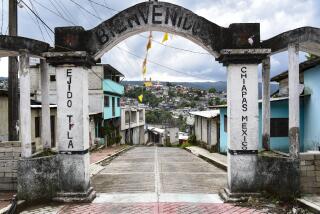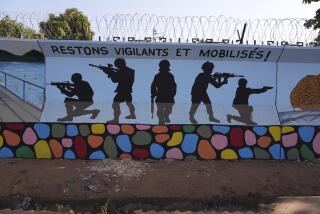A War Without End Roils Colombia
LA MONTANITA, Colombia — Maria Castro knew it was bad when she saw the news that leftist rebels had killed one American and kidnapped three others after a U.S. government plane crashed north of here.
“This is going to bring the war here,” the 78-year-old told her daughter last week as she sat outside her small concrete home in this sweltering village about 20 miles from the crash site in southern Colombia.
Three days later, Castro was outside her home again when she was killed along with Ismenia Gomez, 75. The two longtime friends were chatting on a bright, cool night when they were caught in a cross-fire between police and rebels.
The last few weeks have shown that the rebels of the Revolutionary Armed Forces of Colombia, or FARC, have been forced to change strategies in the face of a government offensive. Unable to directly attack military bases or overrun cities, they have taken on more vulnerable targets -- from bombing cars to seizing Americans, with bystanders caught in the cross-fire.
A year after the Colombian military vowed to take back this region from the rebels, who were allowed to occupy part of southern Colombia during peace talks that collapsed last February, the FARC still controls many rural areas.
Worse, the guerrillas have stepped up attacks in the cities, unleashing a wave of bombings that have left about 50 people dead in the last two weeks and shaken the country.
As children buried their mothers this week and U.S.-built helicopters thundered overhead in search of the missing Americans, frustration filled the air.
“I don’t believe this war has an end,” said Praxedis Perez, 40, one of Castro’s daughters. “Every day, it causes the death of more innocent people.”
President Alvaro Uribe has stepped up the fight against the rebels since taking office in August, increasing the size of the army and police, training civilians in rural areas to take up arms and persuading the U.S. to lend more support. There is no doubt that the offensive has taken a toll. The Defense Ministry reported a 64% increase in the number of rebels killed last year, from 1,029 to 1,683. Arrests of guerrillas doubled, from 1,776 in 2001 to 3,553 last year.
The number of rebels turning themselves in to government demobilization programs increased after Uribe took office, on average from 100 a month to about 150. These fighters have described food and weapon shortages among the ranks.
They also have not been able to mount any major offensives against military bases. In the late 1990s, such attacks were routine.
“They are now more restricted in their movements. They have to restrain themselves,” said a commander with the 12th Brigade, the local Colombian army unit, who did not want to be identified.
American and Colombian intelligence experts also believe that the U.S.-backed program to fumigate hundreds of thousands of acres of coca plants, used to make cocaine, has affected the rebels’ financing.
Guerrillas receive hundreds of millions of dollars a year from the cocaine trade, which accounts for 90% of the drug sold in the U.S. The rebels have also moved into the processing and transport of the narcotic.
Banks and money-transfer facilities in coca-growing zones have reported sharp drops in cash flows. At one police checkpoint in Putumayo, a southern province where much of the coca is grown, the number of people moving out of the region jumped from two families a week to eight a day after spraying operations last fall, U.S. officials said.
Cattle growers from Arauca province in the northeast to this province, Caqueta, in the south say rebels are stealing cattle; the fighters used to make token payments for the animals. And people stopped at guerrilla checkpoints have reported being robbed of watches and jewelry, a new phenomenon.
“Our most recent visit to Putumayo confirmed that the once-vibrant coca economy has been devastated by the spray operations,” a U.S. official involved in the program said last fall.
In response, the guerrillas have taken to waging a war in a different way. True, they no longer mount large-scale attacks. Instead, they carry out small operations -- bombing cities and attacking infrastructure.
Rebels are believed to have bombed a private club in Bogota, the capital, on Feb. 7, killing 35 people. A week later, they were accused of setting off explosives in a home near a regional airport and killing 16, including nine police officers and a prosecutor. Attacks on electrical transmission towers plunged Arauca into a seven-day blackout.
The rebels’ control of some rural sections of Colombia seems as strong as it ever was. The crash of the U.S. government plane is a case in point.
The Cessna Caravan 208 crashed Feb. 13 after reporting engine troubles during a flight. On board were a Colombian army sergeant and four American civilians working for the U.S. military’s Southern Command, which oversees operations in Latin America.
Their mission is still unclear, though contract workers in the region do everything from mapping drug crops to maintaining helicopters. The plane was less than 20 miles from the regional military headquarters when it reported trouble. The pilot had the misfortune to crash-land a few hundred yards from the site of a meeting between rebel commanders from two FARC units that involved a total of between 50 and 100 guerrillas, according to the 12th Brigade official.
Though the army was on the scene within an hour, the rebels had disappeared into the mountainous countryside. They shot the Colombian in the chest and one American in the head at close range, according to a Colombian medical examiner’s office. The U.S. Embassy has declined to release the American’s identity, citing the family’s wish for privacy.
The three other Americans apparently were taken captive, their whereabouts still unknown. The Colombian army Thursday began dropping pamphlets from helicopters in the region, advertising a reward of more than $300,000 for information about the men.
The kidnappings were more proof of just how much freedom and control the guerrillas enjoy in some remote areas.
“It’s not strange to see guerrillas in the countryside,” said 2nd Lt. Dario Solartes, one of the police officers attacked in La Montanita this week. “The strange thing is not seeing them.”
The massive rescue operation launched for the missing Americans -- with the U.S. government supplying intelligence information and advice -- left vulnerable places such as La Montanita, about 240 miles southeast of Bogota. On Sunday, rebels from the FARC’s 15th Front -- suspected of being among the units that participated in the kidnapping of the Americans -- stormed the southern town from three sides.
Police Lt. Jose Lancheros had gone to make a phone call, walking to a store a block from the bunker-like police station surrounded by sandbags on the town’s flower-filled square.
A squad of rebels saw him and opened fire. Lancheros and some of his men returned fire. Castro and Gomez, the two women, died in that first blast of violence.
The attack might have been a simple diversion to draw the military away from the chase for the kidnappers. Or it might have been a power play designed to show the village who still controlled the area.
“Maybe they were trying to show their presence in the zone, or maybe they were trying to make news,” Lancheros said. “But it’s not like that. We’re here.”
Whatever the motive, the message was bitter -- one of war without end, of a government unable to protect its people.
The villagers filled the small church and spilled out onto the square to say goodbye to Castro and Gomez, whose lacquered brown coffins sat on simple wooden chairs. It was a hot, beautiful day, the square bursting with yellow hibiscus and pink bougainvillea.
Men in jeans and women with wilted bouquets sweltered in the heat as a priest decried the violence that resulted in the women’s deaths. They sang. They knelt. They prayed.
Outside, in front of Castro’s home, the family had set up a tent to shelter relatives and friends who came by to pay their last respects. One man noted that Gomez had fled her home in a nearby province nearly 50 years ago to escape an earlier civil war called simply “La Violencia.” More than 200,000 people were killed in that war, and Gomez had come to La Montanita seeking peace.
“She fled the violence,” the man said, “but the violence found her.”
More to Read
Sign up for Essential California
The most important California stories and recommendations in your inbox every morning.
You may occasionally receive promotional content from the Los Angeles Times.










